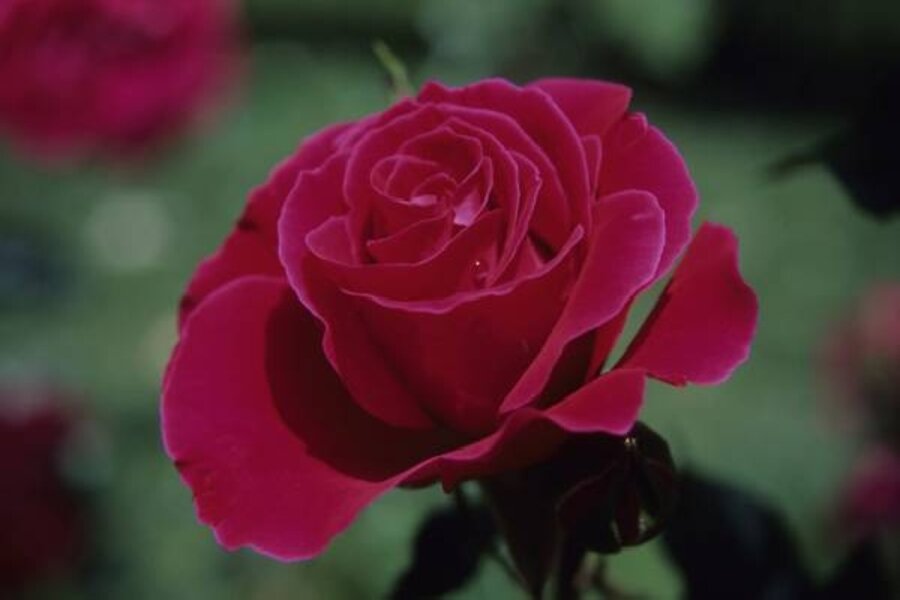Roses have their problems, but still...
Loading...
Read about roses, talk to other gardeners about growing them, and insect and disease problems seem inevitable.
Problems begin in the spring, with chewed leaves. No great harm, except that the plants begin to look ragged. This raggedness is mostly a problem if your roses are planted prominently in view, which makes a good case for planting roses in a dedicated cutting garden, just for their cut flowers.
The cause of those ragged leaves early on is rose chafer, a tan beetle with long, spiny legs. Fortunately, the chafer is up and about for only three or four weeks. Sit out the damage and perky, new leaves will eclipse the chewed ones.
In bad years, handpicking, a temporary cheesecloth fence or insecticide spray could be called for.
Aphids follow on the heels of the chafers, congregating at the tips of stems. That's too bad for the aphids, because perched out there on the stems, they are easy to crush between your thumb and forefinger, or to blast away with a stream of water from the hose.
Even if you ignore aphids, they usually disappear due to diseases and predators before doing significant damage.
Next in line come the two problems most dreaded by rose growers everywhere:
The first is the Japanese beetle, which causes similar damage as the chafer except that it and its handiwork become most evident later in the summer. Plucking or knocking beetles off plants into soapy water in the cool of the morning checks them, as do pesticides, of course, or trying to infect the grub stage with "milky spore disease."
Japanese beetles have their good years and bad. Good years (for them) follow a previous summer of adequate rain making for lush lawns. The beetles then have an easy time laying eggs, and the grubs have plenty of grass roots on which to feed. Unless, of course, you apply the milky spore disease to kill the grubs, something all your neighbors also must do because otherwise the adult beetles can just fly from neighbors' yards over to yours.
The other big problem threatening roses is black spot disease. The name tells all: black spots on the leaves which, as leaves die, are surrounded by yellowed areas.
Black spot can be thwarted in a number of ways, most easily by planning ahead and selecting from among rose varieties that are resistant to it. Cleaning up infected leaves at the end of the season also helps get rid of next year's sources of infection. Annual mulch covers infected leaves that you might have overlooked, preventing spores from wafting up to infect new leaves.
Other problems might also plague roses. Powdery mildew dusts leaves and buds with a mealy, white coating. Rust disease paints leaves a rusty brown color. Sulfur is a relatively benign — to us — fungicide that can keep rose mildew or rust under control, although it shouldn't be used at high temperatures.
Again, the easiest way to avoid these diseases is with disease-resistant rose varieties.
The list of potential rose problems goes on: spider mites, blight, scale insects, and cankers, to name a few. Water sprays, pruning shears, and summer oil sprays are among the many ways to deal with each of these problems.
Avoiding and ignoring also works. Not all pests attack all roses everywhere. Generally, expect to fuss most over hybrid tea roses, less so over English and floribunda roses, and even less over old-fashioned roses. Species roses, such as rugosa rose and Father Hugo's rose, can be well-nigh neglected — except for their beauty, of course.
Sometimes ignoring a rose bypasses all problems. The plants might look ragged and blighted but still pump out enough blossoms for vases indoors.
Editor’s note: For more Monitor gardening, see our main gardening page, our blog archive, and our RSS feed.
You may also want to visit Gardening With the Monitor on Flickr. Take part in the discussions and get answers to your gardening questions. If you join the group (it’s free), you can upload your garden photos and enter our next contest. We'll be looking for photographs of fruits. So find your best shots of summer's blueberries, peaches, plums, etc., and get out your camera to take some stunning shots of early fall apples. Post them before Sept. 30, 2009, and you could be the next winner.





